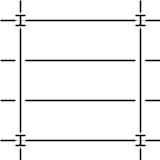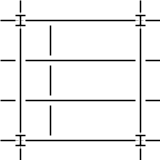Bay Classification
Vibration is a bay phenomenon, not an individual beam phenomenon. Thus it is important that the characteristics of the entire bay be considered, not just those of the individual beams. Design Guide #11 is based on this concept.
According to research, bays with irregular framing rarely experience vibration problems. Bays with beams and girders with differing lengths, orientations, and stiffnesses (and hence differing vibrational properties) do not resonate and hence do not pose a problem. Even seemingly minor variations have often been found to be sufficient to prevent vibrations from achieving perceptible levels. Thus it is not necessary to analyze every beam on the floor for vibration. Design Guide #11 identifies those types of framing configurations that may be susceptible to vibration problems and then describes the procedures for analyzing them. Framing schemes that vary significantly from the regular layouts illustrated in the Design Guide have rarely been found to have vibration problems.
- A "Perfect" bay is one that "perfectly" matches the regular orthogonal bays described in the Design Guide. Beams in those bays are colored blue.
- An "Imperfect" bay is one for which part of the bay exhibits characteristics of a "Perfect" bay but has one or more geometric features that deviate from such. Beams in those bays are colored yellow.
- An "Irregular" bay is one that does not conform to those bays described in the Design Guide. Miscellaneous beams that are not part of a bay are also included in this classification. Beams in those bays are colored gray.
Perfect Bay
- In lieu of four columns, walls may provide the support for the girders or beams.
- Beams within the bay may be unequally spaced, deviating as much as one-half of the average bay spacing. The program will assume that the beams are equally spaced.
- Beam sizes may differ. The program will use the smallest size.
- The beams within the bay may be slightly skewed, as much as 10 degrees.
- Miscellaneous beams within the bay that are parallel to the span of the deck are ignored (see Figure below).
Imperfect Bay
"Imperfect" bays encompass a broad spectrum of configurations. Whenever a beam has, adjacent on both sides, beams of similar length (within 20%) and orientation (within 10 degrees), that beam is considered to be part of an "Imperfect" bay (if it doesn't qualify as a "Perfect" bay). In addition, bays that would otherwise be "Perfect" bays except for certain disqualifying conditions are classified as "Imperfect" bays. These include any openings within the bay, a noncomposite deck or a change of decks within the bay, or interior beams that are a mix of steel beams, steel joists, or C-Beam™ (the girders may differ from each other and the bay can still be classified as a "Perfect" bay).
Irregular Bay
All other beams are considered to be part of "Irregular" bays. This includes, for example, beams that are not parallel to or whose lengths vary significantly from those of adjacent beams. In addition, bays with interior beam spans less than 20 ft. or interior beams with cantilevers or supporting girders with long cantilevers are considered "Irregular".


